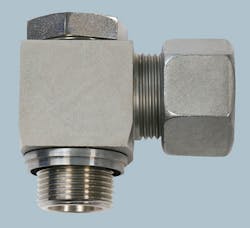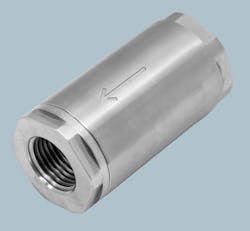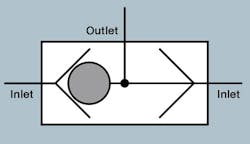DIN 2353 tube fittings are used in a wide variety of fluid power applications, especially in factory, oil & gas, and construction equipment. Metric sizes from 4 to 42mm made of carbon steel or stainless steel are most prevalent. DIN (Deutsches Institut für Normung, translated as the German Institute for Standardization) metric and BSPP (British Standard Parallel Pipe) are the most common thread styles in Europe. DIN type tube fittings conform to the requirements of ISO 8434-1, DIN 2353, and DIN EN 3850 standards. This ensures interchangeability among leading brands of fittings.
DIN2353 metric fittings are available in three series of tube port end connections: tube-to-tube, tube-to-female port, and tube-to-male thread. They are also offered in three different pressure series—LL for Extra Light and intended for low-pressure applications, L for Light and used medium-pressure applications, and S for Heavy, used high-pressure applications. They are identified by measuring the thread size, pitch and the tube’s outside diameter (OD).
As with other compression-style fittings, DIN 2353 fittings consist of a body, cutting ring (ferrule) and nut. DIN connections are used in:
- tube fittings
- alternating valves
- banjo and swivel couplings, and
- check and non-return valves.
A wide variety different configurations and threaded connections enable DIN 2353 fittings to meet many connection challenges. These flareless metric fittings are the most widely used bite-type fittings in the world. As with other compression-style fittings, DIN fittings consist of a body, cutting ring (ferrule) and nut. No O-rings or other elastomeric components are needed to provide a seal. Instead, two cutting edges of a ring (ferrule) bite into the outer surface of the tube, ensuring the necessary holding power and seal for high operating pressures and extreme vibration.
Materials of Construction
As with any fluid power component, DIN 2353 fittings should be made of high-quality materials. Stainless steel 1.4571 (316 Ti) is the gold standard, providing exceptional high-temperature and corrosion resistance. Stainless steel 316 Ti is used in environments with high levels of salt, acids, or near weld seams. Carbon-steel fittings may cost less initially, but the long service life of stainless steel provides a significant reduction in total cost of ownership, leading to fewer parts replacement and lower maintenance costs.
DIN 2353 fittings made of 1.4571 stainless steel fittings withstand harsh environments with the presence of:
- acids,
- dirt,
- high heat,
- shock and impacts,
- salts,
- vibrations, and
- other corrosive substances in the air
Although DIN 2353 fittings and adapters made of 1.4571 stainless steel is especially important for applications requiring extreme temperature and corrosion resistance, carbon-steel can be protected from corrosive environments if the fittings use a suitable coating or plating. For example, Brennan offers a proprietary zinc-nickel plating that far exceeds U.S. and international corrosion resistance standards, including VDMA 24576 class K5.
Zinc-nickel plated fittings should not exhibit any traces of white or red rust even after 1,000 hours of exposure to salt spray testing. Carbon steel fittings can be especially vulnerable to galvanic corrosion when they come in contact with aluminum or stainless steels, so it’s important that the plating offer protection under these conditions. The plating should also readily accept paint, powder coating, or other finishes applied by OEMs. The plating should also be hard enough to resist abrasive wear and provide good high-temperature stability.
Popularity Among U.S. OEMs
For decades, JIC fittings have been the industry standard in the U.S. However, they are more susceptible to cracked flares from excessive torque when tightened. The mated sealing surfaces in DIN metric fittings and O-ring face seal fittings reduce the risk of over-tightening and provide greater reliability because of the elastomeric seal in the mating surface.
As equipment design continues requiring higher pressure ratings, OEMs are choosing DIN metric fittings more frequently. Although JIC and NPT fittings are commonly used in many applications, in many cases they are not rated for higher pressure requirements of today’s equipment, especially when high vibration occurs. Instead, more and more applications require specially-rated metric DIN connections.
With their growing global popularity, many U. S. OEMs are adopting DIN fittings. This, combined with the rise in equipment being imported into the Americas from European manufacturers, is resulting in DIN metric fittings becoming more common in the U. S.
Both male and female versions of metric DIN 2353 24-deg cone fittings have straight metric threads. The tube OD is mated with a 24-deg seat, recessed counter-bore of the male fitting. The female mating component can be a metric DIN 2353 female tube fitting, a metric tube with a cutting ring and nut, or a 24-deg cone with an O-Ring either welded or end-formed onto metric tube. The seat angle should be measured from the fitting centerline using a 12-deg gauge. The sealing of the two components is between the 24-deg seat in the male end and the corresponding female end.
This 90° elbow DIN 2353 fitting has a male thread at the bottom and female at right.
A metric standpipe fitting is made of three preassembled pieces: a bite sleeve, nut, and the standpipe. Standpipe fittings are usually specified for harsh environments, such as high-temperature and aggressive fluids which might destroy soft seals. Agricultural machines often use standpipe fittings because of the frequent use of caustic and corrosive fluids.
Adjustable standpipe fittings facilitate the connection of a metric tube with a 24° conical bore. Tightening the nut onto a DIN 2353 male connection, compresses the bite sleeve onto the tube of the standpipe, which establishes the seal.
Standpipe fittings are usually specified for harsh environments, such as high-temperature and aggressive fluids which might destroy soft seals.
Metric and BSPP (British Standard Parallel Pipe) banjo fittings have two components; a perforated hollow bolt and spherical union for fluid transfer. They are used primarily in medium- to high-pressure applications—up to 800 bar (11,600 psi).
Banjo fittings do not have to rotate relative to the fitting connection; therefore, the hose does not twist when the fitting is screwed into place.
The main benefit of banjo fittings is that they do not have to rotate relative to the fitting connection; therefore, the hose does not twist when the fitting is screwed into place. It also allows the pipe exit direction to be adjusted relative to the fitting, allowing the bolt to be tightened independently.
Banjo fittings are used in many applications, especially in the automotive and mobile equipment markets, such as:
- hydraulic clutch systems,
- brake caliper connectors,
- fuel dosing for selective catalytic reduction systems,
- fuel filter connectors,
- power steering fluid lines,
- turbo charger oil feed lines, and
- variable-valve timing systems.
Check Valves
A check valve, sometimes referred to as a non-return valve, is a spring-loaded valve used in liquid systems where the flow should only go in one direction and safeguards from back flow. These valves can be installed inline and look very much like a large fitting. Because fluid can flow in only one direction, the outer body usually has an arrow pointing in the direction of flow to aid proper installation.
Check (non-return) valves are to allow fluid flow in one direction only. The check valve shown here has an arrow to indicate direction of flow.
Metal sealing surfaces will typically allow some leakage. Therefore, where zero leakage is required, especially when gas or certain hazardous chemicals are being transferred, Buna-N, Viton (FKM), or another elastomer is used to provide a leak-tight shutoff.
A shuttle valve (known in Europe as an alternating valve) is T-shaped and allows flow to pass from one of two inlets to an outlet port. An internal floating ball blocks flow from one inlet port or the other. The port with fluid at the lower of the two pressures will always be blocked, and fluid from the inlet at the higher pressure of the two will always flow to the outlet.
This ISO symbol of a shuttle valve shows how a ball allows flow from only one inlet or the other to flow to the outlet.
The ball in an alternating valve provides metal-to-metal contact with a resilient seal seat to ensure a leak-tight shutoff of liquid or gas. However, they should not to be used with weld nipples, swivel nuts, or any connection that does not allow contact with a shoulder stop in the inner cone. Typical end connections are 24-deg flareless shuttle valve tube style.
Applications and Industries
- DIN 2353 fittings are commonly used in industries where tough environmental conditions are prevalent, especially:
- construction equipment
- drilling platforms
- hydroelectric power plants
- machine tools
- railway technology
- waste and recycling equipment
- shipbuilding machinery
- wind turbines
- mining equipment, and
- other mobile and stationary (industrial) hydraulic equipment.
John Joyce is director of marketing, Brennan Industries, Cleveland. For more information, visit www.brennaninc.com.







